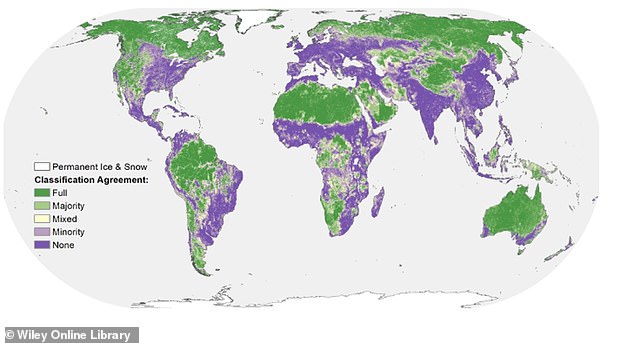About half of Earth’s ice-free land remains unaltered by humans and can still be protected with swift conservation measures, a new study shows.
US researchers compared four recent global maps showing the conversion of natural lands to ‘anthropogenic land’ – land that has been exploited by humans.
Encouragingly, about half, or somewhere between 48 and 56 percent, of the world’s land that is not covered with ice shows ‘low’ influence of humans.
The more impacted half of Earth’s lands, meanwhile, includes cities, croplands and places that have been intensively ranched or mined.
But researchers say humans have the opportunity to conserve about half of Earth’s land for good, rather than exploiting its natural resources.
Intact natural lands can help purify air and water, recycle nutrients, enhance soil fertility and retention, pollinate plants and break down waste – services worth trillions of US dollars annually.
‘The encouraging takeaway from this study is that if we act quickly and decisively, there is a slim window in which we can still conserve roughly half of Earth’s land in a relatively intact state,’ said lead author Jason Riggio at the UC Davis Museum of Wildlife and Fish Biology.
Approximately 15 per cent of the Earth’s land surface and 10 per cent of the oceans are currently protected in some form.
However, governments have been asked to commit to protecting 30 per cent of the land and water combined by 2030 and 50 per cent by 2050.
Convention on Biological Diversity Conference of the Parties 15
The Conference of the Parties is the governing body of the Convention on Biological Diversity, a multilateral treaty signed in the early 1990s.
The convention’s governing body is the Conference of the Parties (COP), consisting of all governments that have ratified the treaty
Among the meeting’s goals is to establish specific targets for land and water protection.
This year’s historic meeting was scheduled to occur in China this autumn but was postponed due to the coronavirus pandemic.
The Fifteenth meeting of the Conference of the Parties (COP 15) will be held in Kunming, China, in the second quarter of 2021.
Leading up to the Convention on Biological Diversity Conference of the Parties 15, there is momentum around setting ‘bold’ conservation targets, according to the research team.
This meeting was scheduled to take place in China this autumn but was postponed to the second quarter of 2021 due to the coronavirus pandemic.
Among the meeting’s goals was to establish specific targets for land and water protection.
However, it had remained unclear how much of Earth’s land area remains without significant human influence and where this land is located – something this new study set out to clarify.
The team used four different methods of spatial assessment to estimate percentages of the Earth’s terrestrial surface.
Overall, 20 to 34 per cent of planet’s land area was shown to have ‘very low’ human influence, while 48 to 56 per cent in total showed ‘low’ human influence.
Three out of four spatial assessments, each with different datasets, agreed on 46 per cent of non‐permanent ice‐ or snow‐covered land as having low human influence.
Among the largest low-impact areas are broad stretches of boreal forests and tundra across northern Asia and North America, and vast deserts like the Sahara in Africa and the Australian outback.
Boreal forests are defined as forests growing in high-latitude environments where freezing temperatures occur for six to eight months – and therefore occupy the high northern latitudes in the Northern Hemisphere.

